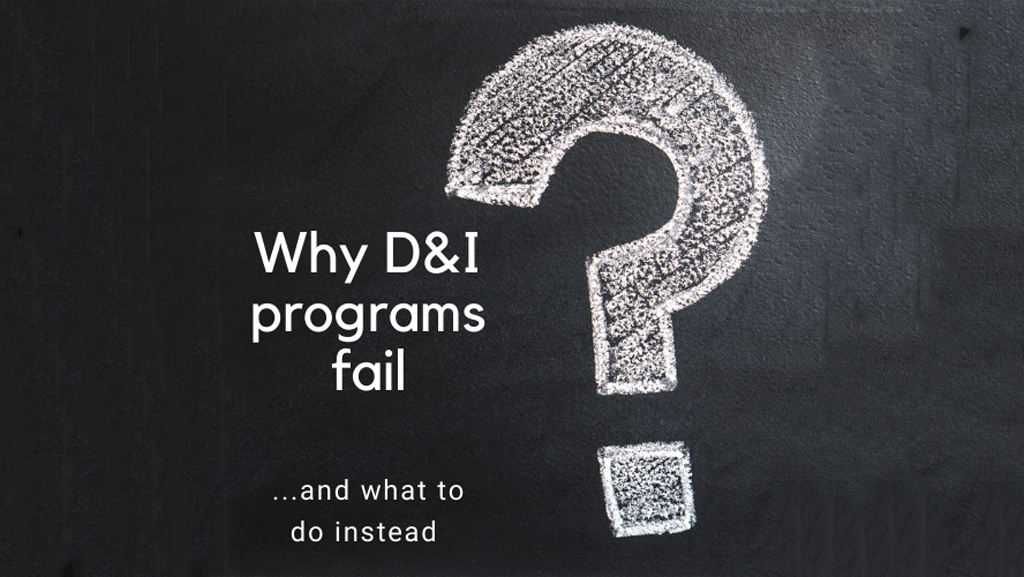Diversity and Inclusions efforts have gained momentum over the last few years, but 2020 saw an unprecedented acceleration in initiatives in the wake of highly publicized cases of racial injustice. Many would call the events of the last year a social and racial justice revolution. Companies are directing more investment to D&I training and publicly pledging their commitment to creating inclusive environments through the hiring of D&I practitioners and high-profile appointments of Chief Diversity and Inclusion Officers.
Yet as we reflect on the success of efforts over the last few years, and specifically over the last year of intense efforts, companies are still battling to report meaningful change. While the COVID pandemic has exacerbated pre-existing gender and racial inequalities, disproportionately affecting women of colour and mothers, even before the effects of the pandemic were evident, multicultural women were considering leaving the workplace in record numbers citing bias and lack of support as the main reasons. A Forbes 2021 survey across respondents in corporate America reported that up to 53% of respondents don’t believe that their employer is meeting its DEI goals. Employees from diverse groups continue to express feelings of being undervalued, excluded and marginalised.
What are some of the more common reasons why D&I programs fail and what can be done to overcome these pitfalls?
1. Creating awareness but not moving to sustainable actions
Most D&I training programs are typically administered at scale and aim to create high levels of awareness of D&I issues amongst employees. But when it comes to practical behavioural change, employees are left wanting. Post training employees are usually left with a heightened sense of awareness, but without the practical advice on what to do NEXT. The result is transformation fatigue, the feeling that efforts are paying lip service to the root cause issues and not resulting in meaningful changes.
Culture is built through the everyday relationships that are created within a workplace which are born through daily interactions.
The most common D&I training programs focus on the topics of privilege and implicit or unconscious bias. However unconscious bias training has done little to shift the dial in changing behaviours. Training which focuses on how privilege plays out typically centers the feelings of privileged groups rather than the experiences of underrepresented groups. Inadequate attention is paid to how privileged groups can utilize their advantages to become allies and to interrupt bias.
Change happens at the intersection of awareness and action
D&I training has to move from the WHAT to the HOW. Culture is built through the everyday relationships that are created within a workplace which are born through daily interactions. Companies need to implement continuous learning programs which create and sustain inclusive behaviours and actively work towards removing bias from all employee touch points in an organisation.
D&I training is not a once off initiative
Companies that are serious about sustainable change will know that hearts and minds are influenced through daily inclusive micro-actions, role modelling appropriate behaviour, inclusive language and communications and creating environments of psychological safety.
Stanford recently published work on the impact of everyday words and language on the creation of inclusive cultures and there is now a plethora of support materials from D&I non-profits, like Catalyst which offers organisations simple, practical and actionable steps on how to flip the script on exclusionary language, what it means to be an effective ally and which behaviours and actions creative inclusive teams, leaders and environments.
2. No strategic ownership of DEI agenda
Companies are increasingly realising that DEI is a strategic business priority, and that ineffective DEI initiatives have far reaching business ramifications.
Yet many companies still place responsibility for DEI strategy and execution into the hands of HR. While HR does have an important role to play in D&I efforts across recruitment, retention, employee engagement and performance management processes, HR as a function has had varied success in establishing themselves as a strategic business partner.
Placing DEI solely in the hands of HR sends a signal that it is a functional responsibility when in fact DEI needs to be owned across the business as an area of strategic importance. Accountability has to ultimately lie with the leadership team. It has to sit with and be owned by the whole executive team and be on their scorecard. The commitment and accountability of the CEO in driving the D&I agenda is vital, and this is an area where even well intended organisations with intelligently thought out D&I programs come undone. It’s the companies where the CEO is actively engaged in diversity efforts and either founded or heads diversity business groups that stand out.
Starbucks announced in late 2020 that they would be linking executives’ pay to the success of inclusion initiatives and would be broadening the scope of mentorship programs by linking underrepresented employees to senior leaders, thereby placing the D&I agenda more firmly onto the scorecard of senior leaders. This is part of the organisations ongoing D&I efforts in the wake of the arrest of two black men who were waiting for a friend at a Philadelphia Starbucks.
3. Focus on diversity numbers and inadequate attention to cultural transformation
While the numbers are an important measure of progress, it does not represent the full picture. It is troubling to still see that many companies still misconstrue diversity and inclusion to be interchangeable terms. Having a diverse workplace does not automatically imply that a company has a culture of inclusion and belonging.
While many companies report on diversity representation numbers, solely focusing on bringing in diverse groups, without attention being given to cultural inclusion and belonging, can have serious negative consequences on employee’s morale and confidence and can result in painful, disillusioning experiences for diverse groups. In these environments employees often report feeling like they are token appointments and experience the emotionally taxing effects of exclusion, resulting in lower productivity and disengagement.
Even companies with impressive diversity representation numbers still battle with attrition of senior talent, particularly women, and underrepresented employees often still report feelings of exclusion, experiencing regular microaggressions and acts of bias and a general inability to fully access opportunities for growth and progression.
Companies have to move beyond the statistics and direct efforts to the real work of creating environments of psychological safety, inclusion and belonging. Removing the visible barriers is only the start, not the destination.
4. Trying to change individuals instead of the places where they work
It is conveniently appealing for organisations to suggest that equality can be achieved if underrepresented groups just change their behaviour. It places onus on the individual rather than on the biased structures and systems in their environment which neutralizes their efforts regardless how much personal accountability they take on.
Yet programs which offer solutions on how to address the common feeling of exclusion, self-doubt and feeling unsure of one’s abilities experienced by marginalised groups, continue to focus on the individual and not enough on the environments in which they work. This can result in setting marginalized groups up for painful experiences if their efforts are neutralised by biased environments, resulting in further feelings of self-doubt and negative back lash from the systems which are not ready to allow them to thrive.
The Lean in brand of corporate feminism is a case in point. Racism and gender inequality are structural and systemic problems. An upheaval of the status quo is unnecessary if all that’s needed for more women to rise is for them to change their behaviour, as originally suggested by the Lean In “can do attitude” manifesto. It placed an unfair burden on women and none on institutions and organisations, when in fact the experiences of women and academic research consistently proves that even the most well intended businesses are not meritocracies and were not created with the intention that everyone can belong.
Harvard Business Reviews, Stop Telling Women They Have Imposter Syndrome challenges this idea again. The concept of imposter syndrome and D&I programs which aim to help women remedy this “ailment” rarely considers the systemic issues which have resulted in women being marginalised and discriminated against, and as a result, creating the symptoms of what has come to be known as “imposter syndrome.”
Organisations D&I strategies must create a culture of inclusion that addresses systemic biases and the invisible barriers which continue to perpetuate – and not on placing the added burden of self-help on marginalized groups.
5. Not applying the lens of intersectionality
“Diversity focuses on the differences that divide people, inclusion focuses on behaviours and cultures that allow diversity to flourish. But no one person is absolutely defined by one aspect of their identity, such as gender or ethnicity, and the concept of intersectionality acknowledges this.” Sarah Churchman, PwC’s Chief Inclusion, Community and Wellbeing Officer
The concept of intersectionality, which is about how people with overlapping identities experience systems of power and oppression, is not a new framework, yet many companies are still not including the impacts of intersectionality into their D&I programs. Identifying and sharing [one’s] multiple identities can help clarify the ways in which a person can simultaneously experience privilege and oppression, or various forms of disadvantage. For example, a black woman is unlikely to experience gender inequalities in a similar way as a white woman, nor racial discrimination similar to that experienced by a black man.
It is important to consider intersectionality in the workplace because our various identities impact our daily lives, affecting how we perceive the world and how the world perceives us. Ignoring intersectionality could result in placing people into homogenous groups and ignoring the layered aspects of their experiences, resulting in groups feeling excluded from D&I initiatives and that they are unable to able to bring their whole selves to the workplace.
According to Stephen Frost, former head of D&I at the London Organising Committee of the Olympic Games and Paralympic Games and co-author of Building an Inclusive Organization, problems arise when single elements (such as gender or race) reduce diversity to a series of competing interests. That’s when you get a “white male backlash” or “Asian on black racism” or “lesbian critics of trans rights”, he explains. “We need, and can get, value from all these people if we lead the overall group inclusively, rather than implement a divide and rule approach.”
Organisations which consider intersectionality in their D&I agenda will be able to create cohesive networks where people from all groups can collaborate. Companies need to interrogate their processes to eradicate the ability to pigeonhole people and instead encourage people to be treated as individuals. Organisations which consider intersectionality are better placed to remove inequality and the reduce the effects of groups with different degrees of power and privilege continuing to marginalise each other.
Some ways this can be achieved in recruitment, for example, is through name-blind CV’s and asking candidates what environment suits them best for interviews. Spotify lets employees take religious holidays that are important to them rather than enforcing a blanket approach.
Looking Ahead
While these are some of the common reasons why D&I efforts fail, and there are certainly others, employees needs and the environments in which companies operate constantly evolves, so it is critical that D&I programs reflect this and are continuously updated and evaluated for success. Change is a gradual progress, there are no “easy fixes” or shortcuts to remedying the complex and long ingrained issues of bias and discrimination, so above all, organisations must be patient and commit for the long haul.


